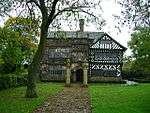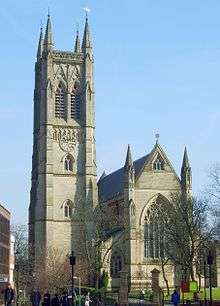Farnworth railway station
| Farnworth | |
|---|---|
 | |
| Location | |
| Place | Farnworth |
| Local authority | Bolton |
| Coordinates | 53°33′01″N 2°23′18″W / 53.5503°N 2.3882°WCoordinates: 53°33′01″N 2°23′18″W / 53.5503°N 2.3882°W |
| Grid reference | SD743060 |
| Operations | |
| Station code | FNW |
| Managed by | Northern |
| Number of platforms | 2 |
| DfT category | E |
|
Live arrivals/departures, station information and onward connections from National Rail Enquiries | |
| Annual rail passenger usage* | |
| 2004/05 | 21,699 |
| 2005/06 |
|
| 2006/07 |
|
| 2007/08 |
|
| 2008/09 |
|
| 2009/10 |
|
| 2010/11 |
|
| 2011/12 |
|
| 2012/13 |
|
| 2013/14 |
|
| 2014/15 |
|
| Passenger Transport Executive | |
| PTE | Greater Manchester |
| History | |
| Original company | Manchester, Bolton and Bury Railway |
| Pre-grouping | Lancashire and Yorkshire Railway |
| Post-grouping | London, Midland and Scottish Railway |
| 29 May 1838 | Station opened as Tunnel |
| 1841 | Station closed |
| September 1845 | Reopened as Halshaw Moor |
| May 1852 | Renamed Halshaw Moor and Farnworth |
| January 1870 | Renamed Farnworth and Halshaw Moor |
| 6 May 1974 | Renamed Farnworth |
| National Rail – UK railway stations | |
| * Annual estimated passenger usage based on sales of tickets in stated financial year(s) which end or originate at Farnworth from Office of Rail and Road statistics. Methodology may vary year on year. | |
|
| |
Farnworth railway station serves the Greater Manchester town of Farnworth, in the Metropolitan Borough of Bolton, England. The station has had several names, the present name being adopted on 6 May 1974.[1]
It lies on the Manchester-Preston Line, though only local services run by Northern call here.
The station received a minor upgrade in 2009, with the addition of automated electronic information display systems and automated announcements audio system similar to the system at Lostock station.
History
The station was first opened by the Manchester, Bolton and Bury Railway on 29 May 1838, and was originally named Tunnel. This station closed in 1841, but was reopened in September 1845, when it took the name of Halshaw Moor. In May 1852 it was renamed Halshaw Moor and Farnworth; in January 1870 Farnworth and Halshaw Moor; and finally on 6 May 1974 it became Farnworth.[2]
Farnworth Tunnel

To the south-east of the station is Farnworth Tunnel, which has two single-track bores, although when built it had one double-track bore. Originally there was intended to be a cutting, but a tunnel was substituted. This was dug from both ends and also from a shaft at the centre; the main difficulty in construction being the nature of the ground, which consisted of wet sand and clay. It is 295 yards (270 m) long.[3]
The Lancashire and Yorkshire Railway (L&YR) route north from Blackburn to Hellifield was completed on 1 June 1880, and the Midland Railway (MR) proposed to use this route for a through service between Manchester Victoria and Scotland. The MR intended to use Pullman cars, which were larger than the L&YR coaches, and it was found that some of the tunnels on the route were too small and would need to be enlarged. Among these was Farnworth tunnel, which was also in need of extensive repairs; so instead of enlarging it, it was decided to build a second tunnel alongside. The present down (northbound) single-line tunnel was commenced on 26 April 1880 and brought into use on 5 December that year, although Parliamentary approval for its construction had not been obtained: it was applied for in February 1881 and granted retrospectively (as part of the Lancashire and Yorkshire Railway Act 1881, 44 & 45 Vic chapter 135) on 18 July that year. Once it was in use, the two tracks through the original tunnel were replaced by a single track along the centre; the tunnel lining was repaired and thickened, and this tunnel then formed the up (southbound) single-line tunnel.[4]
As part of the forthcoming electrification scheme, the original tunnel has been enlarged to allow sufficient clearance for the overhead wires and for both lines to be routed through it once again.[5] During this period, the 1880 bore was initially retained to permit a limited diesel service over the route to continue during the upgrade work, and after was then abandoned as clearances within are too restricted to allow safe operation with overhead wires. This has also required realignment of the lines approaching it and consequent alterations to the platforms that they serve.[6] Work began in May 2015, when the 1838 bore was closed, filled in with cement and re-bored to a larger diameter using the largest tunnel boring machine ever built in Britain.[7] During tunnelling, the workers ran into loose/soft sand, which caused the project to be delayed from October to December and also led to the temporary closure of some lanes on the A666 road above for safety reasons.[8] The TBM finally bored through on 25 October 2015, 21 days after the scheduled completion date. The newly widened tunnel reopened on 14 December 2015, after a scheduled engineering possession on the preceding weekend to connect and test the track & signalling equipment.[9] The first train through was the 05:30 on 15 December from Horwich Parkway station, and the first passenger to use it was former councillor Andrew Morley.[10] At the end of January 2016, the tunnel was closed as the temporary tracks were taken out and replaced with the permanent tracks that are essential for the 100 mph speed limit. The tunnel will be closed later on when putting up the electric wires and pylons for the electric trains in December 2017.
Services
There is an hourly service northbound to Wigan Wallgate and southwards and eastwards to Manchester Victoria from early morning until early evening.[11]
There is one late evening service (Fridays & Saturdays only) at 23:10 to Bolton and Wigan Wallgate (a rail replacement bus runs Monday-Thursday). Services have been suspended for several months due to the tunnel & station upgrade works mentioned above - they have now resumed, as the project has been completed. Originally planned to end in October 2015, this was subsequently been extended to the December 2015 timetable change. The extension to the works has been caused by excessive wet sand deposits being discovered in the overlaying land by Network Rail engineers, severely hampering progress of the boring machine.[12] The station reopened (along with the tunnel) on 14 December 2015.
There is no Sunday service.
References
- ↑ Slater, J.N., ed. (July 1974). "Notes and News: Stations renamed by LMR". Railway Magazine. London: IPC Transport Press Ltd. 120 (879): 363. ISSN 0033-8923.
- ↑ Butt, R.V.J. (1995). The Directory of Railway Stations. Yeovil: Patrick Stephens Ltd. pp. 235, 112, 94. ISBN 1-85260-508-1. R508.
- ↑ Marshall, John (1969). The Lancashire & Yorkshire Railway, volume 1. Newton Abbot: David & Charles. p. 29. ISBN 0-7153-4352-1.
- ↑ Marshall 1969, pp. 190,192
- ↑ "Powering Ahead" Railway Strategies article 25-03-2014; Retrieved 2014-09-06
- ↑ Pictured: Massive machine that will bore tunnel under A666 as railway is electrified Robertson, N; Bolton News article; Retrieved 12 March 2015
- ↑ Pigott, Nick, ed. (March 2015). "Tunnel to be re-bored". Headline news. The Railway Magazine. Vol. 161 no. 1368. Horncastle: Mortons Media Group. p. 8. ISSN 0033-8923.
- ↑ Network Rail Media Centre - "A666 lane closures while train tunnel is enlarged underneath"Network Rail press release - 29 September 2015; Retrieved 2 December 2015
- ↑ Northern Rail News - Update on Farnworth Tunnel - 26 November 2015 Northern Rail news article; Retrieved 2 December 2015
- ↑ "Horwich man thrilled to become first passenger to travel through newly built Farnworth Tunnel". The Bolton News. Retrieved 2015-12-15.
- ↑ GB eNRT December 2015 Edition, Table 82
- ↑ Manchester to Preston electrification - Project Update September 2015Network Rail; Retrieved 8 September 2015
Further reading
- Marshall, John (February 1962). B.W.C., Cooke, ed. "Farnworth Tunnel". The Railway Magazine. Vol. 108 no. 730. Westminster: Tothill Press. pp. 127–8.
External links
| Wikimedia Commons has media related to Farnworth railway station. |
- Train times and station information for Farnworth railway station from National Rail
| Preceding station | |
Following station | ||
|---|---|---|---|---|
| Moses Gate | Northern Manchester-Preston Line |
Kearsley | ||


